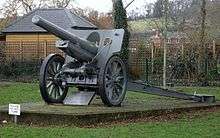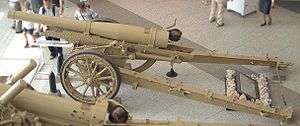Type 96 15 cm howitzer
| Type 96 15 cm howitzer | |
|---|---|
|
A battle damaged Type 96 at Yasukuni Shrine | |
| Type | Howitzer |
| Place of origin |
|
| Service history | |
| In service | 1937–1945 |
| Used by |
|
| Wars |
Second Sino-Japanese War Soviet-Japanese Border Wars World War II |
| Production history | |
| Number built | 440 |
| Specifications | |
| Weight |
4,140 kg (9,130 lb)[1] Firing, 4,920 kg (10,847 lb) Traveling |
| Length | 6.71 m (22 ft 0 in) Firing, 9.25 m (30 ft 4 in) Traveling |
| Barrel length | 3.523 m (11 ft 7 in) 23.37 calibers |
|
| |
| Shell | 31.3 kg (69 lb) |
| Caliber | 149.1 mm (5.87 in) |
| Carriage | split trail |
| Elevation | -5 to +65 degrees |
| Traverse | 30° |
| Rate of fire | 3–4 rpm |
| Muzzle velocity | 540 m/s (1,772 ft/s) |
| Maximum firing range | 11,900 m (13,014 yd) |
| Sights | panoramic |
The Type 96 15 cm howitzer (九六式十五糎榴弾砲 Kyūroku-shiki Jyūgo-senchi Ryūdanhō) was a 149.1 mm calibre howitzer used by the Imperial Japanese Army during World War II. It was intended to replace the Type 4 15 cm howitzer in front line combat units from 1937, although it fired the same ammunition.[2] The Type 96 designation was given to this gun as it was accepted in the year 2596 of the Japanese calendar (1936).[3]

History and development
Work on developing a new field howitzer for the Japanese Army began in 1920 and continued for over a decade. The Japanese Army sent numerous military attachés to Europe during World War I and observed the effectiveness of sustained artillery barrages against fixed defenses and opposing infantry.[4] The final specifications to meet the Army's requirements called for a howitzer that could be elevated to 65 degrees, with a maximum range of 12,000 yards, which could be transported by a team of six horses. The new design was ready by 1934, but Army Chief of Staff Kazushige Ugaki opposed its production until further tweaks were made. Production finally commenced in 1937. A total of 440 units were produced.
The revised Type 96 howitzer could be identified by a relatively short tube with muzzle only slightly forward of rectangular cradle, three demountable spade plates and demountable trail block for each trail end, wheel chocks and leaf springs above the axle.[3]
Design
The Type 96 15 cm howitzer was regarded by Allied military intelligence to be one of the most modern, well designed and effective weapons in the Japanese arsenal. Mounted on sturdy, rubber-shod, wooden wheels, the weapon was normally tractor drawn. One of its outstanding characteristics was its extreme elevation capability of 65° (which could only be used when a deep loading pit was dug beneath the breech.[5] Although the Type 96 (1936) 150-mm howitzer has been made in considerable quantity since the time of its adoption, it has not yet completely replaced the Type 4 150-mm howitzer in Japanese medium artillery units. The Type 96, the last artillery weapon developed during the period of redesigning, is heavier than the Type 4, has a somewhat greater range, and travels as a single load drawn by tractor. In travel, it is jacked up on a leaf spring. During firing, the spring is depressed so the piece fires off its axle. The Type 96 uses the same ammunition as the Type 4.[3]
Ammunition used included high-explosive shells, as well as armor-piercing, Shrapnel, smoke and incendiary tracer shells.
Combat record
The Type 96 15 cm howitzer was first used in combat in the Second Sino-Japanese War and was highly praised by its users. It was also used at the Nomonhan Incident in the Soviet-Japanese Border Wars.
After the start of the Pacific War, it was assigned to Japanese units at the Battle of Bataan and Battle of Corregidor in the Philippines, as well as at the Battle of Guadalcanal. Many units were at the Battle of Okinawa.[6] It continued to be used as the main howitzer of Japanese artillery units until the end of World War II.[7]
A surviving example is preserved at the Yushukan Museum at Yasukuni Shrine in Tokyo. Additional examples can be found in a parking lot in Bellevue, Washington, just east of 124th Ave. NE on the Bel-Red Road (complete with gun shield but without the breech block), and in front of the Veterans Memorial Building in San Luis Obispo, California, USA, although that one is in poor condition.
References
Notes
- ↑ Taki's Imperial Japanese Army page
- ↑ Bishop, The Encyclopedia of Weapons of World War II.
- 1 2 3 War Department Special Series No 25 Japanese Field Artillery October 1944
- ↑ Mayer, the Rise and Fall of Imperial Japan. pp. 57–59
- ↑ http://www.ibiblio.org/hyperwar/Japan/IJA/HB/HB-9.html#III US Technical Manual E 30–480
- ↑ Chant, Artillery of World War II
- ↑ Taki's Imperial Japanese Army page
Bibliography
- Bishop, Chris (ed.). The Encyclopedia of Weapons of World War II. Barnes & Noble. 1998. ISBN 0-7607-1022-8.
- Chamberlain, Peter and Gander, Terry. Light and Medium Field Artillery. Macdonald and Jane's, 1975. ISBN 0-356-08215-6.
- Chant, Chris. Artillery of World War II. Zenith Press, 2001. ISBN 0-7603-1172-2.
- McLean, Donald B. Japanese Artillery; Weapons and Tactics. Wickenburg, Ariz.: Normount Technical Publications, 1973. ISBN 0-87947-157-3.
- Mayer, S.L. The Rise and Fall of Imperial Japan. The Military Press, 1984. ISBN 0-517-42313-8.
- War Department Special Series No 25 Japanese Field Artillery October 1944
- US Department of War. TM 30–480, Handbook on Japanese Military Forces. Louisiana State University Press, 1994. ISBN 0-8071-2013-8.
External links
-
 Media related to Type 96 15 cm Howitzer at Wikimedia Commons
Media related to Type 96 15 cm Howitzer at Wikimedia Commons - Taki's Imperial Japanese Army page
- US Technical Manual E 30–480
